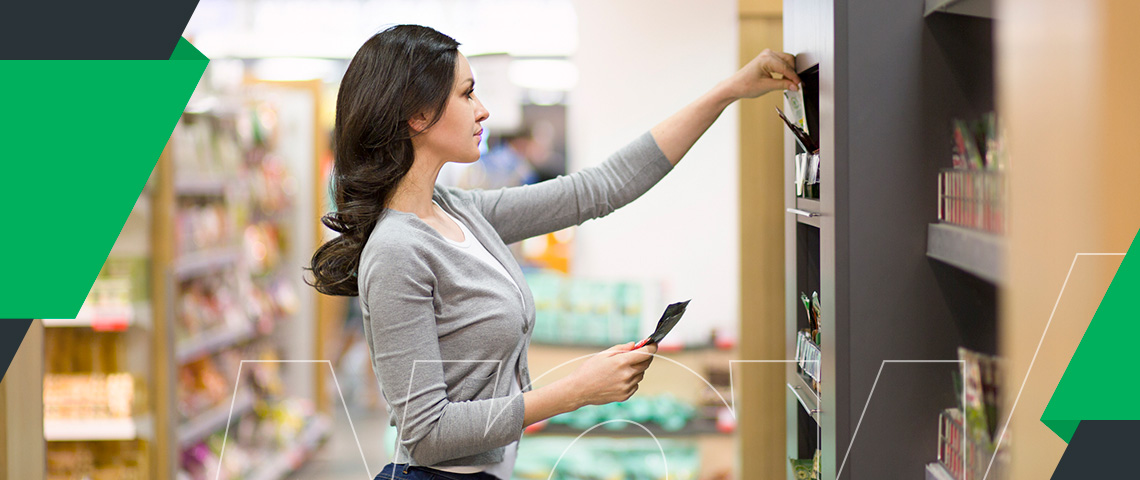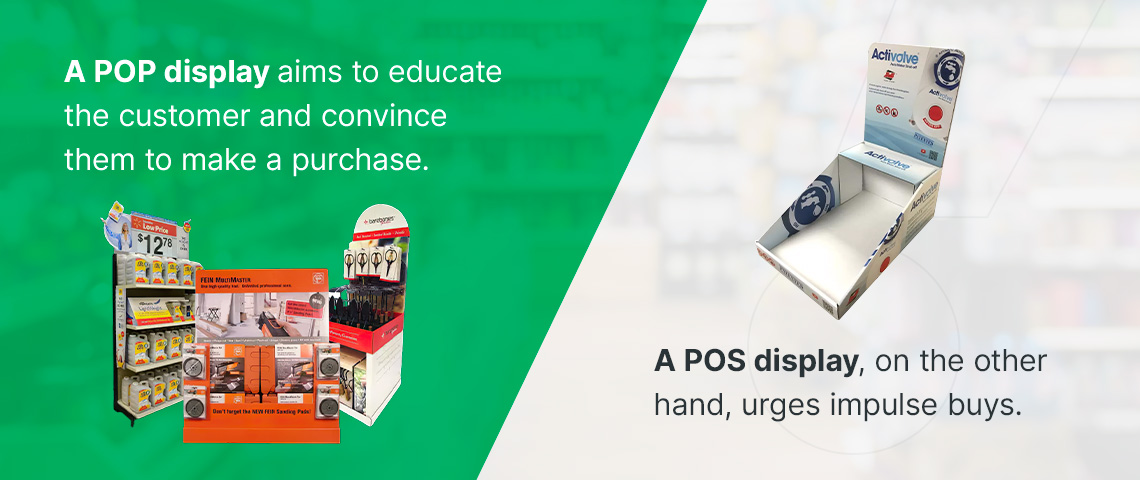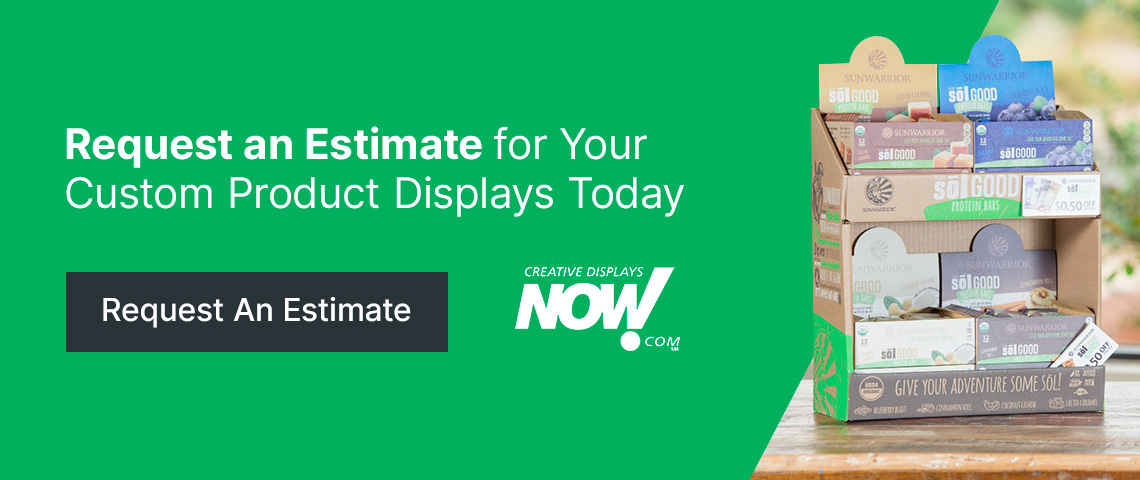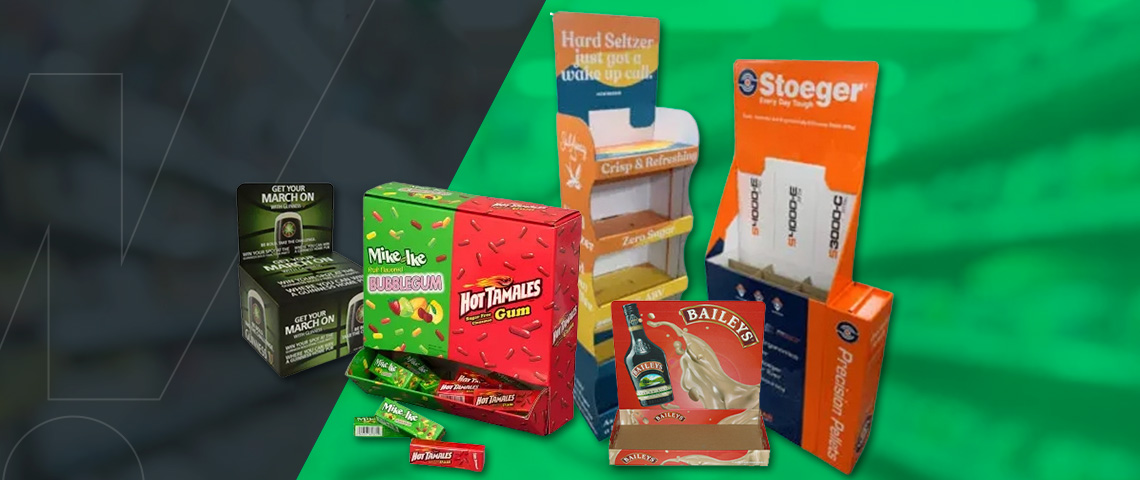If you’ve dipped your toe into the world of retail displays, you’ve probably heard the terms POS and POP before. These abbreviations, short for point of sale and point of purchase, are often used interchangeably. We’re here to dispel the confusion and explain exactly what sets point-of-sale and point-of-purchase displays apart so you can pick the best one for your needs.
What Are Point-of-Purchase Displays?
Point-of-purchase (POP) displays are structures located where a customer is making a purchasing decision. In other words, POP displays are found in a product placement zone, such as a retail entry point, the end of an aisle or the middle of the store.
At a POP location, customers can learn about a current promotion and a product’s unique selling points. They can decide if a product will benefit them and whether they’ll toss it in their cart.
By definition, a point-of-purchase display features a product through special shelving, point-of-sale signage or stands.
What is a Point-of-Sale Display?
Point-of-sale (POS) displays are specialized structures found at the checkout point of a retail location. POS displays allow you to best optimize the time your customers spend while they are otherwise just standing in line, waiting for their turn to check out. At the point of sale, shoppers have made their decisions and are ready to complete their purchase. Anything else they buy at this point usually isn’t planned and done with little thought.
What Are the Differences Between POP and POS Displays?
Though POP and POS displays promote products and boost revenue, there are a few key differences:
1. You’ll Only Find POS Displays at the Register
You can think of a POS display as a more narrow version of a POP display. While POP displays refer to general product displays throughout the store, POS displays refer to just one area — where customers make their final purchase. In most retail locations, the POS is the checkout counter or cash register. POS locations can also refer to a digital checkout page for online retail.
2. POS Displays Hold Smaller Quantities
Unlike POP displays, which usually take up shelving or floor space, POS displays are often smaller and hold single-packaged items. Custom POS displays can be designed to fit exactly in the space you have, and offer products more likely to sell. Think pre-packaged candies, energy bars and small seasonal items. At this stage, shoppers are done browsing and ready to buy. As a result, a point-of-sale product display is an invaluable opportunity to drive last-minute impulse sales through attractively designed displays and conveniently placed products.
POP displays are typically bigger than POS displays and can hold more items. POP displays are also great for promoting multipackaged items, like cases of soda.
3. They Serve a Different Purpose
A POP display aims to educate the customer and convince them to make a purchase. They feature enough space to include a brand’s mission, product benefits or company story. They might feature eye-catching graphics and custom shapes. For instance, if you walk into any grocery store, you’ll likely find a colorful, attractive endcap display promoting a new or seasonal product.
Customers are meant to interact with POP displays. They might read the text on the display, pick up the product, look at it closely and decide if it’ll benefit them. POP displays are perfect for spreading brand awareness and promoting a new product or sale.
A POS display, on the other hand, urges impulse buys. POS displays appeal to a customer’s mood or desire to enjoy something pleasurable. Customers often don’t plan to purchase something near the register, but if an item catches their eye, seems like it’ll serve a need like hunger or thirst, and is reasonably priced, they’re bound to buy.
POS displays often hold gum, candy, magazines, small cosmetic items or toys. Every customer who purchases something in your store will have to pass POS displays during their checkout, which can often allow just enough time to encourage them to leave with a little something extra than they may otherwise have.
Point-of-Purchase Display Examples
POP displays come in various sizes, shapes and colors. You can place a POP display in a high-traffic area anywhere in a store. Some examples of POP displays include:
1. Dump Bins
Dump bins are large corrugated cardboard containers that typically go in the middle of an aisle. They’re often used to hold a large quantity of small items. Customers love to rummage through clearance items in a dump bin. Dump bins also make attractive displays for fruits and vegetables.
2. Endcaps
Endcaps are situated at aisle ends. They might be an extension of a gondola and include attached shelving and signage or a freestanding floor display. Endcap displays are one of the largest displays available and are great for advertising beverages, snacks or household cleaning products.
3. Shelf Talkers
Shelf talkers are promotional signs attached to a shelf. They might include a product’s name, brand logo and essential details. Sometimes, they’ll come with tear-off coupons urging customers to try a product.
Point-of-Sale Display Examples
POS displays are designed to fit neatly on or near a checkout counter. They’re small but sturdy and pack a big punch. Here are a few examples of corrugated cardboard point-of-sale displays:
1. PDQ Display
PDQ stands for “products displayed quickly.” These displays may come assembled and stocked with products for quick setup. You can place PDQ displays anywhere in a store, but they’re typically used to sell products fast near the cash register.
A corrugated cardboard PDQ display has room on the sides and front for attention-grabbing graphics and key product details.
2. Counter Display
Counter displays are small and light. They’re made for countertops and placing products within easy reach. Counter displays are ideal for holding impulse buys like candy bars, lip gloss or phone chargers. Customers won’t be able to resist noticing your product if it’s in a colorful counter display right in front of them.
3. Gravity Feed Display
A gravity feed display is typically small and includes a sloped shelf. The design allows products to move forward when a customer removes the first one in line. It’s an easy way to create the look of a well-stocked display. Gravity feed displays are excellent for holding candy, gum, smokeless tobacco, beverages and other fast-moving products.
Which Display Style Is Best for Your Products?
With a clear understanding of the difference between point-of-sale and point-of-purchase displays, it’s time to unpack which style best suits your products. The answer generally depends on your objective. Either POS or POP displays might be the right fit if your goal is to:
- Stay versatile: By nature, POP displays offer more flexibility than POS structures. They can be placed throughout a store and range from endcap shelving and large dump bins to eye-level floor structures. You’ll have a wider range of opportunities to mix and match your display strategy throughout a retail location with this type of marketing. POS displays, on the other hand, are more limited in location and scope.
- Gain brand awareness: Focused on garnering some attention for your brand? You can spread POP displays throughout the store for maximum brand awareness potential. However, don’t neglect the importance of a POS display. This high-traffic area means every single customer who makes a purchase will be near your display, raising your odds of getting their attention.
- Increase revenue: At the end of the day, businesses want retail displays that work. The good news? Depending on your product, both POS and POP displays can offer an effective sales strategy. If your product is small enough to be promoted near the checkout area, a POS display can lead to higher impulse sales. POP displays will let you take advantage of the full scope and size of a store and maximize your potential to be seen in high-traffic areas.
Many businesses choose to use a combination of POS and POP displays. If you do the same, you can make sure your products are front and center throughout a store — when customers are browsing and buying.
Request an Estimate for Your Custom Product Displays Today
Want more info about POP displays and point-of-sale display design? Read our Beginner’s Guide to POP Displays for more information.
With a clear POP and POS display definition in mind, it’s time to take advantage of both styles for yourself. At Creative Displays Now, we’re excited to help you place your product front and center. We do everything under one roof, from display design to distribution. We also understand popular retailers and their display specifications and requirements.
Reach out to Creative Displays Now to request an estimate for your custom displays.





